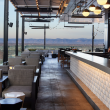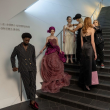Ten years in the making, CRUSH WALLS has become a must-see festival in Denver. What started as a grassroots graffiti weekend has evolved into a week-long, cornerstone event that showcases the inspiring talent of local artists next to international ones. This past week, the alleys and streets in RiNo were packed with onlookers — from first-timers to long-time fans — proving that CRUSH is a steering force in the Denver cultural scene.
With all of that influence, CRUSH organizers — including founder Robin Munro, president of the RiNo Art District Tracy Weil and creative director of CRUSH Alexandrea Pangburn — made some great decisions this year in their curation and programming. In contrast to last year, the event didn’t let the momentum of popularity eclipse the original vision of CRUSH — also known as Creative Rituals Under Social Harmony — to build community through art. Rather, the festival let the artists do what artists should do: express their opinions. This led to more conversations, connections, questions and ultimately, more interaction with the community.
This resulted in a festival that felt more charged than in recent years —with much of the art having a serious purpose or message behind it. Maybe it’s timely, or maybe it’s because CRUSH has finally garnered a level of respect from the rest of the city — allowing it to have more freedom than a “graffiti weekend” would have had in the mid-2000s.
In case you missed the interesting week filled with artists using different techniques, materials and inspiration, we’ve broken it down into a shortlist of highlights.
Representing Indigenous Communities
Coalescing with the artist talk that happened on Thursday, September 5 at RedLine, where street artists (mostly of color or other marginalized communities) discussed their struggles and triumphs, this year’s CRUSH encouraged artists to speak their mind and their truth. This resulted in a handful of pieces that spoke the truth about (or from the point of view of) indigenous peoples.
Mostly, the indigenous peoples represented were Native Americans, from the black and white portrait by Zehb_1 to the dramatic piece by Gregg Deal that includes a quote about evicting people from their land. But, Nicaraguan-born Luis Valle (aka El_Chan_Guri) painted a stylized image of a woman and child that expresses both South American Indigenous cultures and North Native American cultures, with the help of some pattern work by Denver-based artist and co-founder of the Birdseed Collective, Anthony Garcia Sr. “The imagery of the woman and child represents the vulnerability of Indigenous ways of life” Valle explained, as well as the hopefulness of the future.
Tribal Murals — aka Alicia DeOlivera Cardenas — participated for the first time this year, with a corner spot in the alley that gets the most foot traffic throughout the year, on the side of 10 Barrel Brewing. She creates murals that are her prayers and uses recycled paint. When her mural was complete, a Native American ceremony was conducted in front of the mural, including people wearing traditional headdresses and clothing.
Political Pieces
Street art started as a political act. Whether you trace it from graffiti (which is an even more political act than street art tends to be) or you trace it from artists like Banksy and Blek the Rat, the origins are steeped in activism, opinions and revolution. Which is why the proliferation of “Instagram-worthy murals” or “gentrification wallpaper” as some call it, has posed a problem to purists and fans who crave rebellion in their street art.
But, as a few CRUSH artists showed us this week, RiNo is not lost to the gentrification wallpaper — yet. Jonathan Saiz and Andi Todaro — two artists with impressive lists of gallery and museum exhibitions and projects — created a mosaic-inspired mural on the side of Crema Coffee that packed a lot of social commentary into one cohesive piece of art. Juxtaposing old imagery that you might see in ancient temples with modern emojis, the duo simultaneously elevated modern icons with traditionally sacred ones, leading to the question “what is sacred anymore?”
Shannon Galpin created wheatpaste collage poems that came directly from the letters of a stalker she had in the past, who harassed her and people she cared about for years. It’s part of a series she’s calling “Love Letters” — a chilling reminder that abuse happens in many different forms.
The most rebellious piece that went up this past week was created by Denver street artist and graffiti writer Guerilla Garden/Jolt in the back parking lot of Barcode. It depicts a rhino in the RiNo Art District colors, charging at a woman standing in front of a small house. White people sit atop the rhino, one holding bags of money, another with an e-scooter, a woman doing yoga and a girl taking photos with her phone. The rhino is accompanied by a snarling wolf — which is probably a stab at the developer who is notorious in RiNo and has associations with CRUSH.
Women Showed Up In Force
Last year in our review of the festival, we called out the organizers for not representing the growing number of women street artists in Denver and abroad. It was a boy’s club and it traditionally has been a boy’s club — like the rest of the street art and graffiti scene. But this year, more ladies showed up, demanded walls and created masterful pieces. Artists like ChromaJ and Chelsea Lewinski found a way to participate, even if they weren’t originally invited, by working with friends that were given walls as part of the festival or by brokering their own deals with other walls. This shows an incredible amount of bravado and courage, and we give those women kudos. Other women worked with their peers to create collaborative murals, like Lindee Zimmer, Danielle DeRoberts and Sara Michaels on the backside of Modern Nomad — or Alexandrea Pangburn and R0melle on Larimer and 26th Streets.
When it was all said and done, CRUSH’s representation of women reached or maybe even just exceeded 30%. It’s a good number that probably needs to be raised even more next year. But with the momentum and inspiration from this year’s turnout, we are sure that won’t be a problem.
—
CRUSH is maturing every year, making it an event that is pivotal in Denver’s growing cultural ecosystem, and will continue to be an axis for creativity and public art. But, it’s also the perfect format to allow artists the freedom to express their true opinions, even if that means that a wall mocks the sponsors of the festival for a year. To that, we tip our hats to CRUSH and the rebellious spirit that it has tried to maintain throughout its existence. The question might be, what will the next 10 years hold for this festival?
More Photos
We can’t help ourselves, so here are more photos for your viewing pleasure.






This year’s festival was 40% women.
Hi Dean, my approximate calculation was based on numbers of groups, not individual artists. So, for instance, Ladies Fancywork Society, who work as a group of 4, was counted as one since they only produced one piece. I did the same thing for groups or pairs of men who collaborated on one wall together. If you count individuals, it is closer to 40%, but that does not account for the number of people in each graffiti crew, since they are not listed on the website. I have a suspicion that if we counted all members of the graffiti crews, the proportion would once again be closer to 30%.